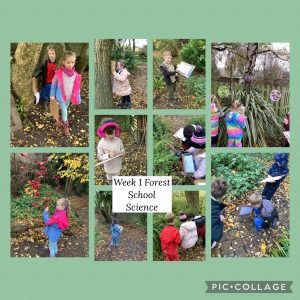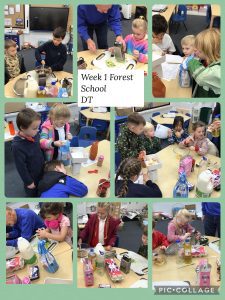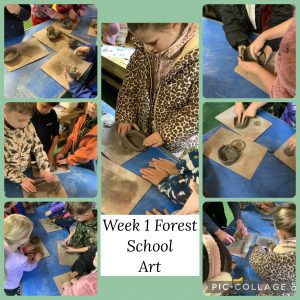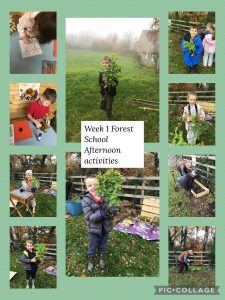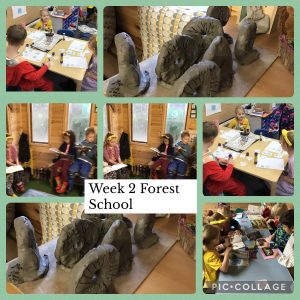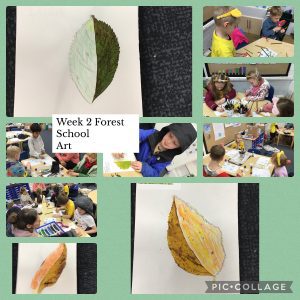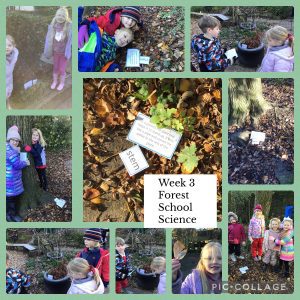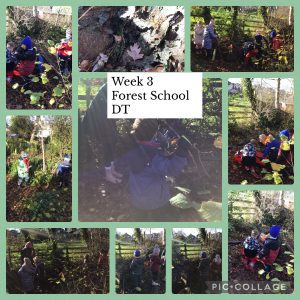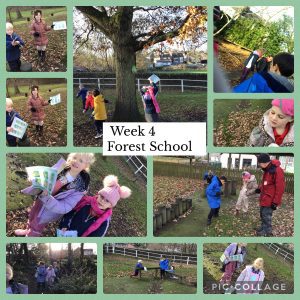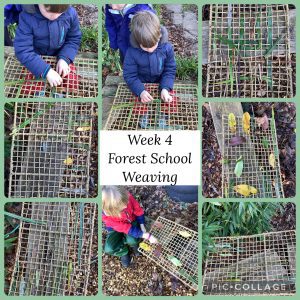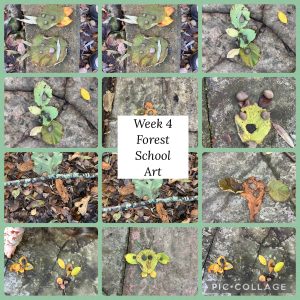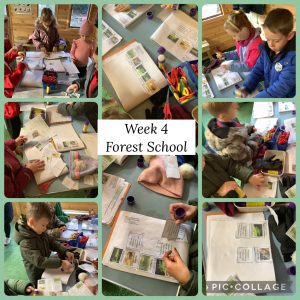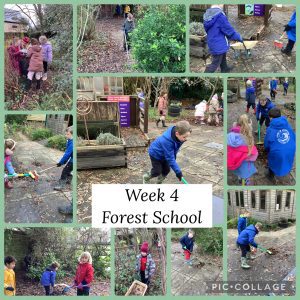“A friendly, creative, environment for learning together”
Forest School Class 5
Autumn 2025
Week 1
Today was our first full day of Forest school and what a fun day it was!
As part of our science learning, children explored and collected examples of things that are living, dead, and never alive. We discussed how to decide which category each belonged to- some items sparked great debates, like whether fallen leaves are dead or still part of a living tree.
With Mrs Platts, children identified different trees in and around the school garden. We learned how to tell the difference between evergreen and deciduous trees, spotting clues in leaf shapes, bark patterns, and whether the trees keep their leaves all year. We then demonstrated out knowledge of trees when playing the woodcutter game on the field.
With Barry and Miss Seaward each group followed a recipe to make a delicious chocolate courgette cake. Measuring, mixing, and stirring kept everyone busy- and we discovered that courgettes can make cakes extra moist and tasty!
In art with Neville, we used clay to make pinch pots, inspired by ceramic artist Penny Withers. Rolling and stacking coils took careful hands and patience, we collected natural materials from the garden and used these to decorate out pots.
In the afternoon we came together for a range of afternoon activities: bug hunting, den building, gardening and making colorful leaf rubbings. We enjoyed a special visit in Forest School, where out visitor Joe helped us create raised beds and plant bulbs- we’re excited to watch them grow and bloom in the spring!
A brilliant start to our six weeks of Forest School adventures!
Week 2
Although our Forest School day was wet and rainy, we continued our learning indoors, making great use of both the classroom and the Hive in our school garden.
This week at Forest School, we talked about different minibeasts and matched them to the habitat they prefer. The children discussed why certain creatures choose certain places- from the damp, shady homes of woodlice to the sunny, flower-filled spots loved by bees.
With Mrs Platts, we learned about pollination and the stages of plant reproduction. The children ordered the steps from flower growth, to pollination, seed formation, and finally new plant growth.
We practiced careful observation by making detailed pencil drawings of leaves. The children paid close attention to shape, edges, and vein patterns- the results showed fantastic focus and patience.
Taking inspiration from Barbara Hepworth, the children created 3D clay sculptures. They explored shapes, holes, and smooth versus textured surfaces.
Week 3
This week in science, we explored the school garden to find micro-habitats- under logs, in leaf piles, beneath stones, and among the plants. We looked closely at what creatures lived there and thought about why these environments provide just what they need to survive.
Ms Seaward took us to look at the flowers in the garden, we matched each plant part to its name and talked about its function. Roots, stem, leaves, flowers, and seeds all have their own role in helping the plant grow and reproduce.
We got creative outdoors, using natural materials like leaves, stones, petals, and twigs to create our own pieces of land art, inspired by the work of artist Marc Pouyet. The children’s designs were full of colour and texture.
With sticks, leaves, pinecones, bark, and other natural materials, we worked together to construct a bug hotel. The children thought carefully about the types of spaces insects might like to hide in. We can’t wait to see who moves in over the coming weeks!
In the afternoon, children were busy with gardening, making leaf and stick men in the garden and using leaves and twigs to make leaf kebabs!
It was another busy, hands-on day at Forest School, and we can already see the children’s confidence and curiosity growing
Week 3
This week in Forest School, children became leaf detectives. The children explored the garden on a leaf hunt, searching for different shapes, colours, and textures. They worked together to identify which tree their leaves came from and shared their findings with great enthusiasm.
Children enjoyed a creatvie activity weaving using weaving frames and natural materials. The children collected sticks, grasses, and leaves to thread into their frames, experimenting with patterns and textures. They showed great focus and creativity as they wove their natural materials.
Children collected leaves, stick, and stones to make pictires of their favourite animls. The children showed lots of creativity as they arranged textures and colours to bring their designs to life!
Looking closely at insects, we discussed what an exoskeleton is and why insects have them. The children learned how these hard outer coverings act like armour, giving protection and support.
Children worked together carefully to help with gardening!
Forest School Class 6
Autumn 2025
Week 1
We were so excited this morning for our first Forest School day. The weather was dry so we could explore the garden and play games on the field.
What a great day we all had! Here is what we got up to…
As part of our Science learning, we learnt how to classify objects into ‘Living, Dead and Never alive’- did you know that to be a living thing it needs to grow, eat and breathe! We loved looking for things that were living, dead and never alive, we found lots of exciting things.
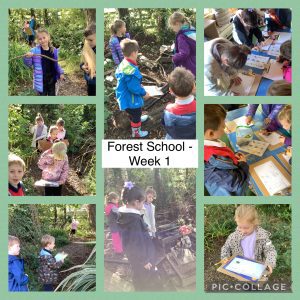
Mrs Platts also helped us to name and identify some of the different trees in the school garden. We ticked off the ones we could find including an Oak tree, Silver Birch and Ash. Mrs Platts told us lots of ways we can identify different trees throughout the 4 seasons. We then demonstrated our knowledge of trees when playing the woodcutter game.
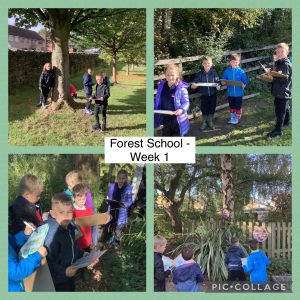
In Art we used clay to make coil pots. We collected natural materials from the garden and used these to decorate our pots. We took inspiration from the Sheffield Artist Penny Withers.
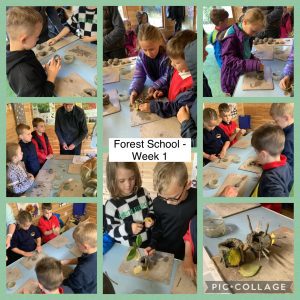
With Barry and Miss Warnes we made a chocolate courgette cake as part of our DT work. We talked about healthy and unhealthy foods. We measured ingredients, mixed them and learnt how to safely use the graters. It was really yummy!
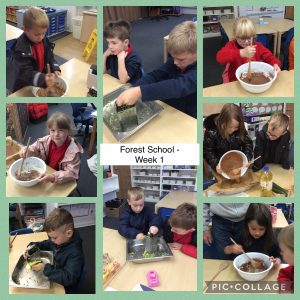
Week 2
What a beautiful sunny day at forest school!
This week in Science we learnt about micro–habitats and what animals would live in these places. We thought about why a mini-beast would choose to live in a certain habitat.
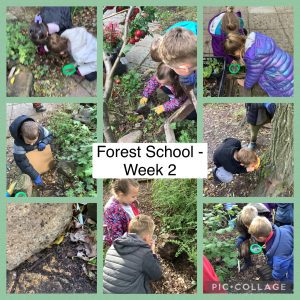
Mrs Platts took us to look at the flowers in the garden. We discussed the different parts and functions of plants with Mrs Platts. We know that the roots not only take water to the plant from the soil, but also help to anchor it to the ground.
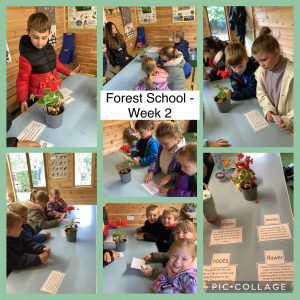
Our DT focus this week was making bug hotels with Barry and Neville. We made some fabulous habitats for mini-beasts and hope to encourage more into the school garden.
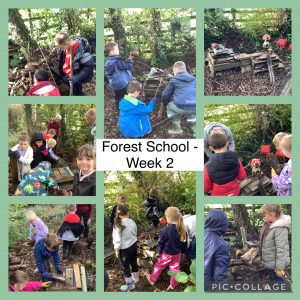
This week we looked at the artist Marc Pouyet and created our own land art using natural materials.
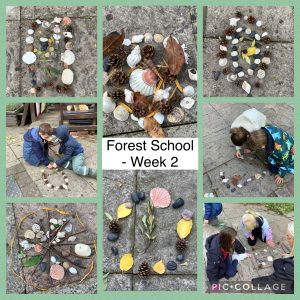
Week 3
What another sunny day at forest school!
As part of our Science learning we continued to look at animals and plants that live in local micro-habitats and explain why. We found a woodlouse under a tree stump and talked about how it is dark and damp under there and a good habitat for them.
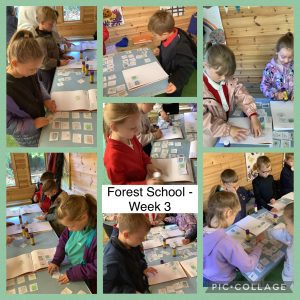
With Miss Travis we began to learn about how flowering plants reproduce through pollination and pollinators such as bees.
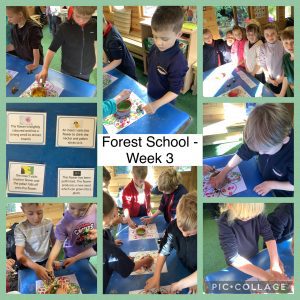
In Art this week we created a mirror observational drawing of a leaf. We had to think carefully about line, shape and scale. We then used colours to add detail onto our drawings.
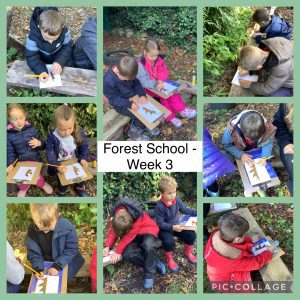
We collected natural materials from the garden such as twigs, leaves and stones to make a collage. Some of us created a pattern and others used the natural materials to make an animal collage. We loved looking at the different colours of the Autumn leaves which had begun to fall from the trees.
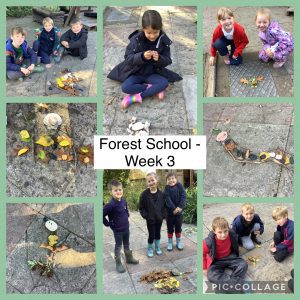
Week 4
We have had another great day at forest school despite the rain!
This week we were thinking about the word adaptation in Science. We talked about what adaptation means and we began to explain how and why some minibeasts have adapted to their habitats to help them survive. Did you know what some minibeasts have an exoskeleton on the outside of their body to keep them safe?
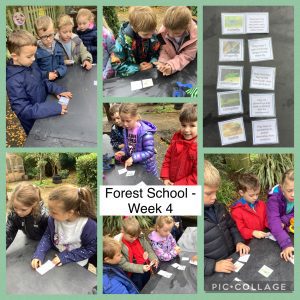
With Mrs Leaf we looked at plant lifecycles. Just like us plants live, reproduce and die. We ordered the stages of a plant’s life and explained what happens at each stage. We used some new vocabulary such as the word germination.
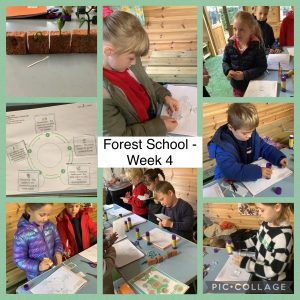
As part of our DT learning we revisited the skill of whittling sticks with Mrs Platts. In the afternoon Mrs Platts showed us how to tie knots and we used the sticks to make weaving frames. We then choose some natural materials from the garden to weave with.
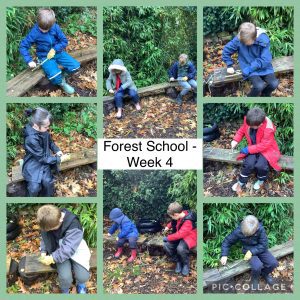
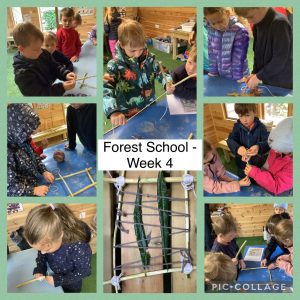
As part of our Art learning this week, we looked at the sculptures created by Barbara Hepworth. We used clay to create our own sculptures inspired by her work with Miss Warnes and Neville.
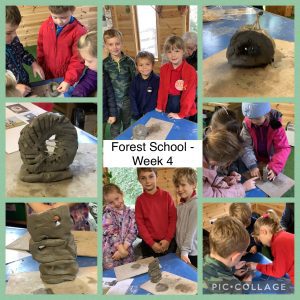
Week 5
This week we learnt about food chains. Do you know what the difference between predator and prey is? Or producer and consumer? We created some food chains together thinking about the minibeast/animals in our school garden. We then played a food chain game on the field.
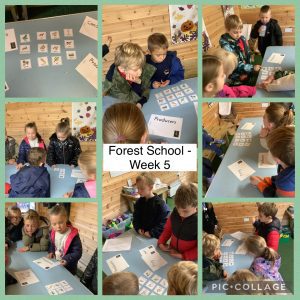
This week we made apple and carrot tray bake. We had to use a knife, peeler and grater safely to prepare the ingredients. In the afternoon we ate our muffins.
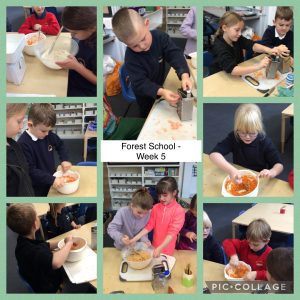
In DT this week we used sticks to create a bow and arrow. Barry and Neville showed us how to make them and string a bow correctly.
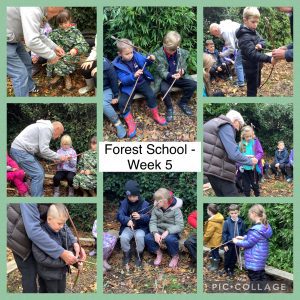
In art we looked at the artwork by Georgia O’Keefe. We created our own observational drawings of flowers using oil pastels. Take a look at our beautiful artwork.
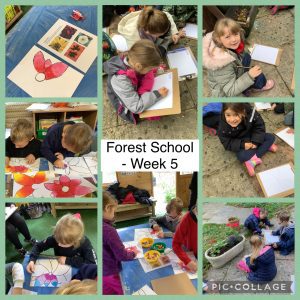
Week 6
This was our final week of Forest School!
In the morning we went on a local walk and put our learning to use. We identified several trees on our walk such as an Oak tree and Hawthorne tree. We also saw some animals such as cows, goats and even a badgers toilet.
We even played the game Poohsticks which was such good fun.
Neville also told us an old story about pack horses. We had to close our eyes and listen carefully to the story. We were sure we could hear the horses nearby but when we looked there were none there.
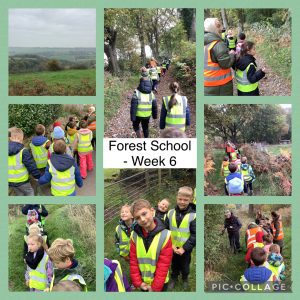
As a special treat Mrs Platts spoke to us about fire safety and we lit a fire in the school garden. We all got to chance to toast a marshmallow and they were delicious!
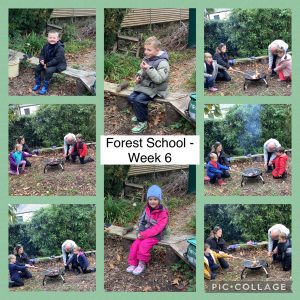
It was a fabulous way to end our Forest School learning at Stannington Infant School!
